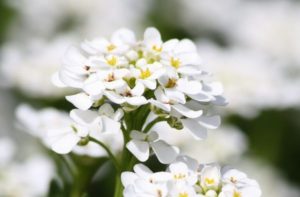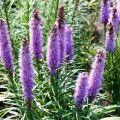Rules for planting and caring for evening primrose in the open field, description of varieties
Decorative evening primrose attracts gardeners and landscape designers with its simplicity and variety of species. The perennial flower has a large number of varieties that are found in both the south and north. Most of them are of selective origin, but invariably include such a feature as bright numerous inflorescences. The popular evening primrose flower, the planting and care of which will be described below, is called primrose in botany. In addition, the plant is called a night candle or evening primrose.
Description and features
Evening primrose inflorescences are the main advantage of the plant, the flowers are white, yellow, red or blue, and also striped. The creeping rhizome produces hard, pubescent shoots, the height of which depends on the variety. The leaves are always arranged alternately, and have a variety of shapes. The peculiarity is that flowering occurs in the evening, and the buds do not close even in cloudy rainy weather. Evening primrose varieties have a one-year, two-year, or multi-year growing season.
Growing in the garden
Enotera is effortlessly grown in garden plots. The bush does not need to be repotted frequently, the plant does not require special feeding and sophisticated care. The flower perfectly coexists with other crops, has strong immunity and tolerates bad weather conditions well.
Seedling method
Small evening primrose seeds are more suitable for seedlings. The usual seedling potting mix is placed in small containers. In each, a small depression is made up to 5 mm and seeds are poured, mixed with sand and earth. The soil is sprayed with water to prevent waterlogging and decay. It takes up to 14 days for seedlings to appear.
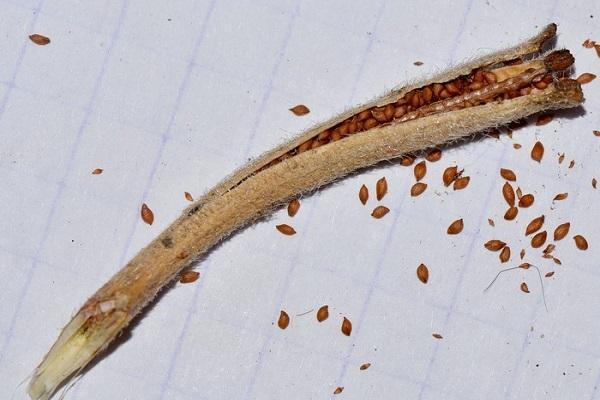
Timing
You can sow evening primrose seedlings from January to March. The exact dates will be indicated on the seed package, as they depend on the variety. Seedlings are planted no earlier than the beginning of May. The soil should warm up well, be moistened with melt water and have time to dry out. It is desirable to protect young plants from possible frost..
Soil requirements
Soil composition is not particularly important for evening primrose cultivation.The varieties bloom beautifully on all types of soil, with the exception of poor heavy clays. The plant normally reacts to acidity, but grows more actively on neutral loose loams rich in nutrients.
Temperature regime
Immediately after sowing evening primrose, the containers must be tightly covered with polyethylene so that the seedlings receive a sufficient amount of heat.
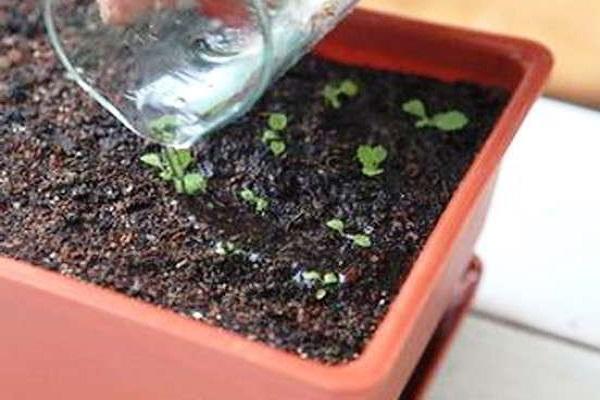
Airing
After 8-10 weeks after sowing, the seedlings must be hardened. To do this, you need to take the containers outside during the daytime. The necessary conditions are sunny weather and no frost. You can start with 10-15 minutes and gradually increase the time spent in the air.
Thinning
After 10-15 days, the seedlings must be thinned out. Excess shoots are carefully removed, but it is recommended to simply plant them in another container. Some of them will take root and are used for planting in the future. Thinning of plants sown in one large container is especially important.
Outdoor transplant
By May, the seedling grows the required number of true leaves and has a developed root system. Plants are planted in moistened holes one at a time, completely immersing the roots in the planting hole. The distance between the bushes is at least 50 cm.
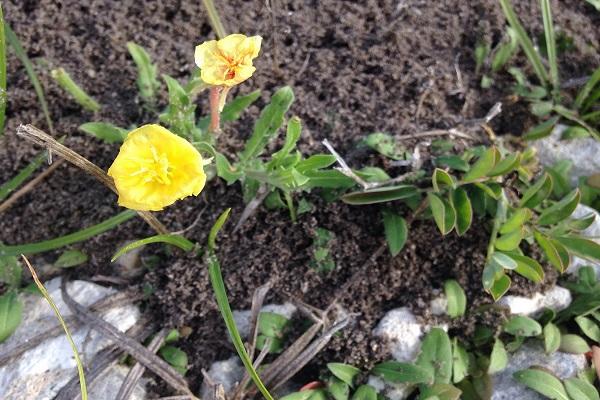
Seedless way
On light soils, such as sandy soils, it is possible to grow evening primrose from seeds in the open field. Before planting, the earth must be dug up, sand is added and, if desired, organic fertilizers are added. In the first year of planting, the plant will grow its root system and is unlikely to bloom.
Timing
Planting time significantly depends on the temperature of the environment. When the air warms up to 16 ° C, you can prepare the soil for planting seeds. After 14 days, they start sowing if the spring cold does not return.
Site selection
The main criterion for choosing a site for planting flowers is illumination. The degree depends on the variety, as there are plants that prefer sun, partial shade and maximum shade. The moisture content of the soil should not be too high, the flower tolerates a short drought more comfortably than stagnant water.
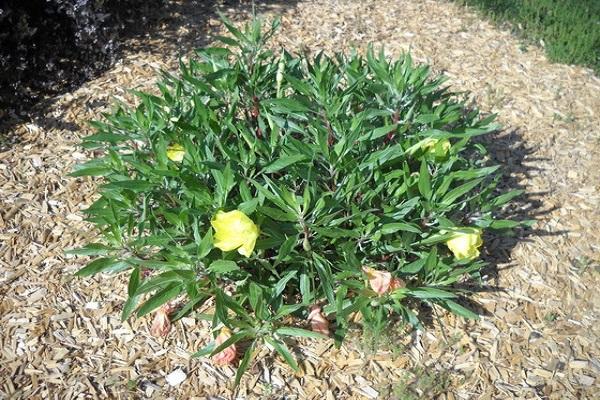
Seed planting scheme
The seeds are sown in groups at a distance of up to half a meter from each other, as evening primrose grows over time. The second landing option is tape. To do this, you need to make grooves up to 50 mm deep in loose soil, pour water over it, then sprinkle the seeds evenly and cover with soil. After that, the ground is lightly tamped.
Thinning
Dense seedlings need to be thinned out to provide space for plants to grow. The sprouts are removed with a thin knife so as not to damage the roots. In this case, excess plants can be planted elsewhere.
Care
Evening primrose is not a demanding plant to care for, however, the shrub should be provided with basic conditions. These include:
- timely abundant watering;
- weeding of weeds;
- fertilization;
- pruning dry parts of the plant;
- loosening the soil;
- mulching;
- tying up.

Watering
Enotera prefers well-moisturized soil and reacts negatively to dry, sunny weather. To achieve the maximum flowering level, it is necessary to water the plants at least 2 times during the growing season. For each square meter of planting, 15 to 20 liters of water are required.
Weeding
It is regularly necessary to loosen the root circle of the evening primrose to remove weeds and increase the access of oxygen to the roots. An abundance of weeds leads to poor growth and poor flowering, and also contributes to the spread of fungal infections and pests.
Top dressing
Low requirements for soil fertility allow you to fertilize evening primrose 1 time during the growth period. There are 2 options for applying top dressing to the soil:
- During flowering, the soil is enriched with potassium sulfate and superphosphate at the rate of 15 mg of dry matter per square meter.
- At the stage of bud formation, add wood ash powder or nitrophosphate to the soil.
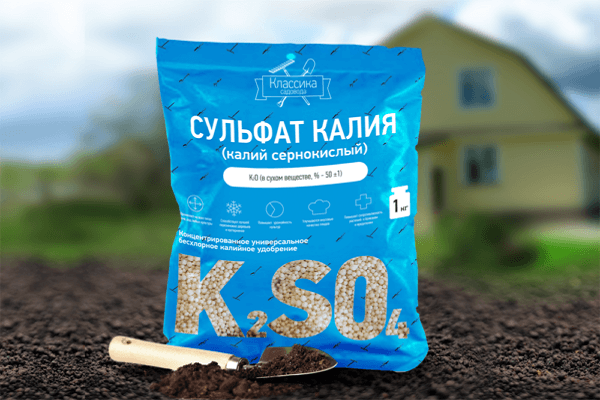
Pruning
Immediately after the end of flowering, sluggish peduncles must be removed from the plants. This increases the nutritional level of the greenery and helps to maintain the attractiveness of the flower bed. At the end of the growing season, which usually occurs in late autumn, the withered shoots are cut along the ground line.
Transfer
Long-term cultivation of evening primrose in one place leads to degeneration, shredding of flowers on growing bushes. At the first signs of deterioration in the appearance of the inflorescences, the plant must be divided by dividing the bush and planted in another place. The procedure is carried out infrequently, the period of stable growth should be at least 4 and no longer than 5 years.
Preparing for winter
Additional shelter for evening primrose is not required for the winter, as the flower is frost-resistant. Before the onset of frost, the aboveground part of the plants is cut off, and then abundant mulching of the planting area is carried out. The height of the cover must be 50 mm. Chopped peat, compost, spruce branches or fallen leaves will optimally preserve the roots.
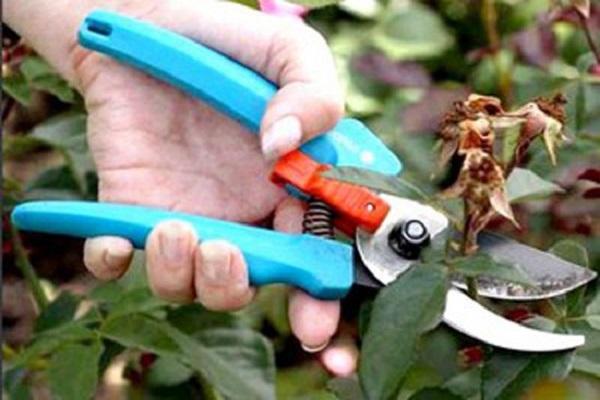
Diseases and pests
Evening primrose has good immunity, especially rarely amenable to infection with fungal infections. If spots appear, you need to remove the damaged leaf and destroy the neighboring plant, which was the source of the disease. Fungicide treatment and preventive spraying are not required. Insects attack evening primrose much more often. The main danger is aphids, which must be destroyed with insecticides immediately after they appear.
Reproduction
There are several types of reproduction of evening primrose: seed and vegetative. In order to get your own seeds, you need to keep the inflorescences until the fruit forms and the seed ripens. However, if you skip harvest time, evening primrose will dissipate naturally. In autumn it is recommended to propagate the bush vegetatively.
Self seeding
Evening primrose reproduces well on its own by scattering seeds. This method is natural for annual species. Seeds around the plant fall out of the fruits in autumn, and fresh shoots appear in spring. It is required to thin them out or transplant them to the right place.
Dividing the bush
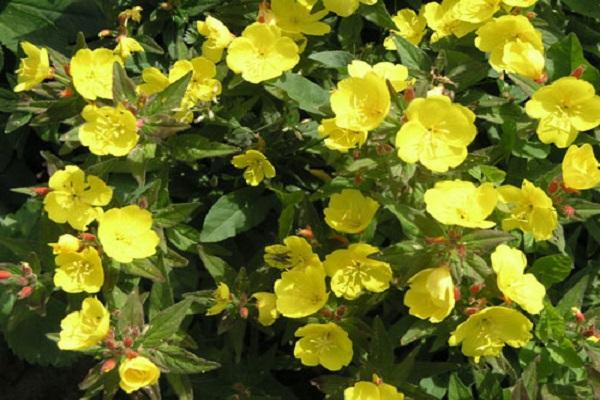
This is the easiest way to breed evening primrose that is already growing in the garden. In this case, it is not necessary to dig out the whole bush, you can cut off a part with a shovel and transfer it to a new place. For rapid rooting, it is necessary to keep a lump of soil on the cut off rhizome. Reproduction is possible both in spring and autumn.
Application in landscape design
In horticulture, externally excellent evening primrose varieties are planted in contrasting combinations. The bushes will create bright areas on green lawns, look good in flower beds with constant partial shade. Plants adorn the northern slopes of alpine slides, fill in and mask flaws well. In the design of the borders and the foreground of the flower beds, low-growing varieties of primrose are used.

Neighbors
To form a contrasting bright effect next to evening primrose, it is preferable to plant:
- lobelia;
- ageratum;
- veronica;
- astilba;
- bells.
These flowers have different shades from the primrose when flowering, and the leaves differ significantly in texture.
Healing properties
Enotera is often used in folk medicine due to its rich chemical composition. The rhizome serves as the basis for the preparation of decoctions against respiratory diseases and tuberculosis. Oil is squeezed out of the seeds of the plant, which prevents thrombosis of blood vessels, and is also used to treat eczema, dermatitis, diabetes, cirrhosis and rheumatism.
Infusion of the green part of evening primrose is an effective anticonvulsant agent, is a part of folk remedies for heart and kidney ailments, has an antimicrobial effect when used externally.
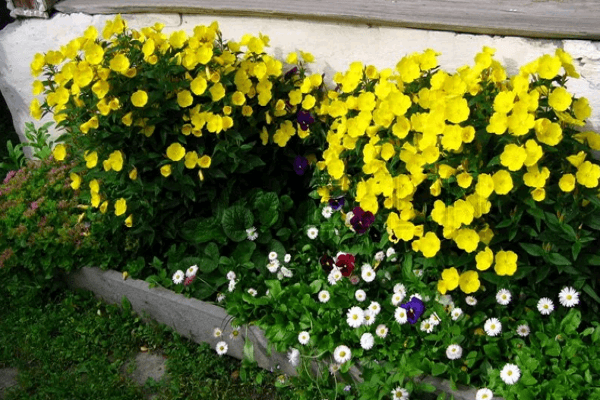
Cooking use
Evening primrose was used by the American Indians for food. Dishes were prepared both from shoots and flowers, and from dense rhizomes. The latter is rich in starch, protein and mineral compounds. The root is peeled, and the resulting pulp is eaten seasoned with vinegar or stewed in a stew.
Kinds
The genus evening primrose or primrose includes at least 150 plant species. Most of these are malfunctioning ornamental plants that are heavily used in landscaping and alternative medicine. Some varieties are also used in cooking.
Missouri
This type of evening primrose is also known under the epithet large-fruited, it is characterized by:
- height no more than 40 cm;
- leaves are oval or strongly narrowed;
- large flowers up to 10 cm in diameter;
- inflorescences of a golden hue are located very low above the ground.
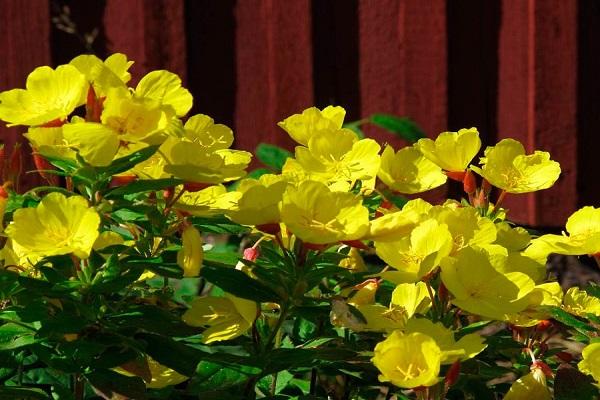
Stemless
One of the most striking types of evening primrose is characterized by:
- lanceolate leaves form a heaped rosette;
- funnel-shaped flowers are large, up to 7 cm in diameter;
- inflorescences have a light yellowish tint.
Shrub
Features of shrub evening primrose:
- height up to 120 cm;
- rich green leaves of a long oval shape;
- yellow flowers are large, not less than 5 cm.
Perennial
The species widespread in North America has been cultivated since the mid-18th century. and has the following differences:
- very small height of 25 cm;
- leaves of a narrow lanceolate shape up to 1.5 cm wide;
- inflorescences are formed like an ear;
- small yellow flowers do not exceed 1.5 cm.
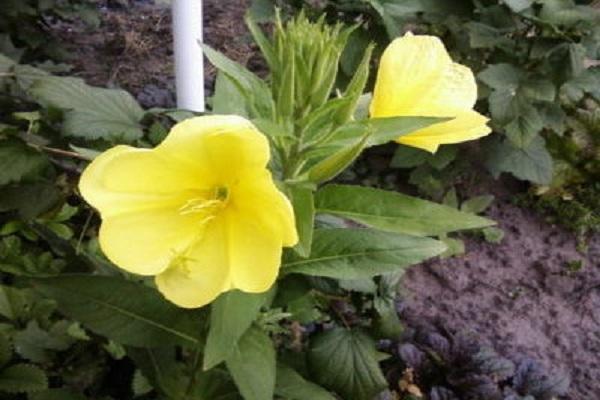
Quadrangular
The species is also native to the eastern United States and is known as the Fraser Evening Primrose. The plant has natural characteristics:
- the average height of the bush is 70 cm;
- oval leaves have a blue-green tint;
- in autumn the plant acquires a reddish tint;
- inflorescences are very fragrant;
- flowers are yellow.
Beautiful
Beautiful evening primrose features:
- undersized shrub 40 cm high;
- leaves are oblong with a carved jagged edge;
- flowers are cup-shaped with a radius of 2.5 cm;
- fragrant inflorescences are white or pinkish.
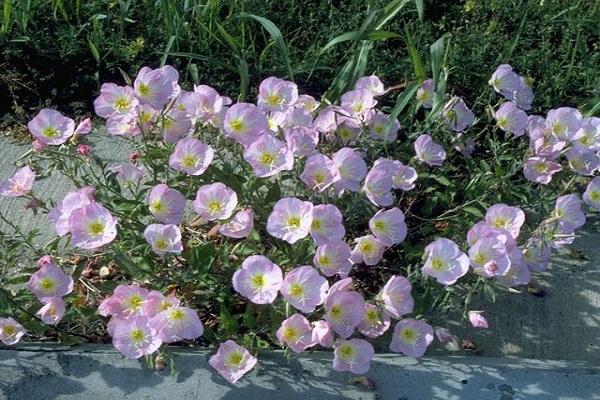
Biennial
Biennial evening primrose characteristics:
- height up to 120 cm;
- leaves 2 cm long have sparse denticles along the edge;
- flower diameter 5 cm;
- inflorescences in a lemon yellow palette.
Fragrant
This type is characterized not only by a bright aroma, but also by the following features:
- love of shade;
- height up to 100 cm;
- flowers are large, yellow;
- inflorescences do not fold during the day.
Pale
Characteristics of evening primrose:
- large snow-white flowers;
- bush height within 50 cm;
- night bloom is accompanied by a pleasant aroma;
- grown in cold climates.
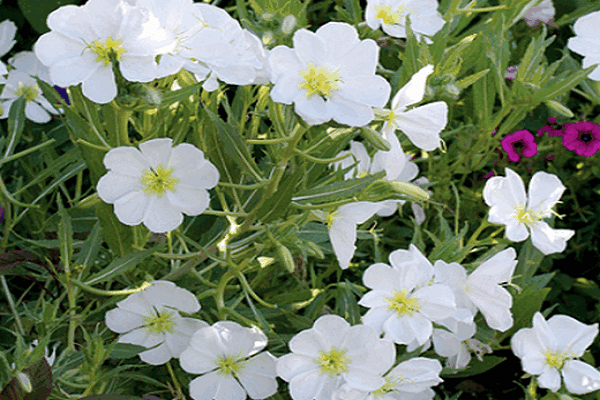
Multicolored
Features of evening primrose:
- growth up to 120 cm;
- flowers of a bright orange hue;
- compact size of the bush.
Lamarck
Enotera Lamarck is also called red-veiled and has the following differences:
- height up to 100 cm;
- leaves are oval rather than lanceolate;
- greenish plants have branchy straight shoots;
- flowers are exceptionally yellow.
Drummond
Drummond evening primrose features:
- height 30-80 cm;
- large, strong stem with strong branching;
- pointed leaves lanceolate;
- the color of the plant is dark green;
- inflorescences are yellow, large, fragrant.
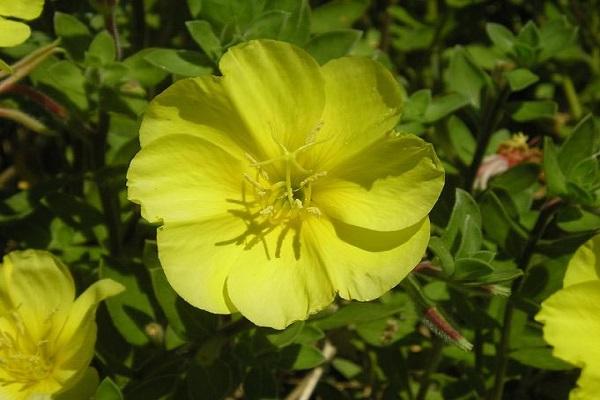
Popular varieties
Each evening primrose species has 5-6 varieties. This significant diversity sets the flower apart from other garden plants. You can easily choose the right one based on the size of the bush and the shade of the inflorescences.
Evening dawn
The variety belongs to undersized, reaching a height of 30 cm. The plant is perennial, unpretentious, prefers light loam with good drainage. The variety is planted in a sunny area. Blooming with large yellow buds lasts from July to September.
Pinocchio
A tall variety up to 120 cm prefers sunlight and partial shade. Regularly shaped flowers are lemon yellow and large in size.Perennial evening primrose is resistant to drought and frost, propagates by seedlings.
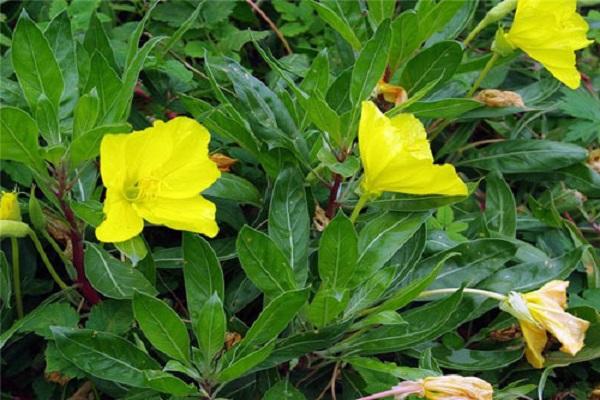
Solveig
Unpretentious bushes 30-40 cm high have single large golden flowers that bloom in the evening and at night. The variety is resistant to frost and drought, does not lose growth in poor calcareous lands.
Gold
Low bushes up to 25 cm high are intended for planting in partial shade. The color of the flowers is yellow, and the diameter is 7-10 cm. When planting the variety, it is enough to observe a distance of 30 cm between the plants.
Night candle
A short evening primrose with a height of 30-40 cm with light yellow flowers prefers partial shade. The variety requires dense shelter for the winter, blooms from June to August only in the evening. The seeds are planted in open ground.
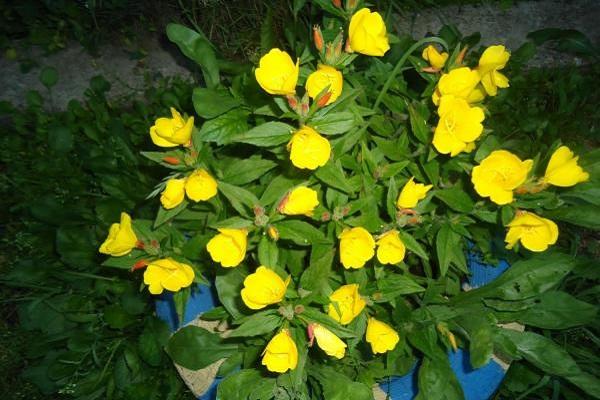
Yellow River
A small biennial variety does not exceed 25 cm. The bush blooms in the second year from June to September. Inflorescences are bright yellow and consist of 5-7 buds.
Pink dream
The shrub is 25 to 40 cm high and has a small number of pink or white flowers in the bud. The seeds can be planted in open ground or in a cold greenhouse. The variety easily tolerates winter under a light cover of fallen leaves and spruce branches.
Coquette orchid-pink
A perennial, low-growing variety does not reach more than 40 cm. Pinkish-white, cup-shaped flowers appear from the end of June and disappear after mid-August. For the winter, it is recommended to mulch and cover with foil.
Evening rose
A perennial shrub reaches a height of 40 cm. In the second year, it is covered with white flowers with a pinkish tint. The variety is grown in a seedling way, unpretentious in care, but requires high-quality drainage.
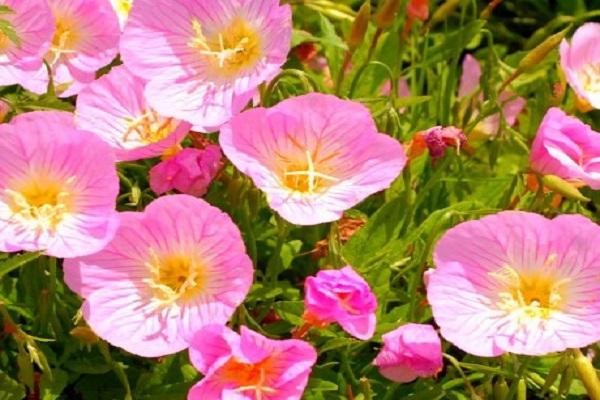
Free wind
The variety belongs to medium-sized, has straight stems up to half a meter high. White flowers bloom singly in the evening and at night. The plant is suitable for planting on alpine slides.
Care secrets
Features of caring for evening primrose bushes:
- The high degree of drought tolerance allows the plant to be watered no more than 3 times a year.
- It is permissible to apply mineral fertilizers before watering.
- The bushes need to be rejuvenated every 4 years.
- Evening primrose can be transplanted even during the flowering period.
The high immunity of the flower does not require prophylactic spraying with pesticides.

